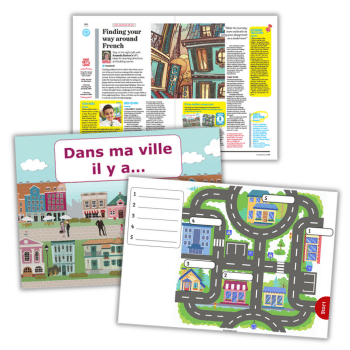Le Chat Got Your Tongue? – How Non-Language Specialists Can Teach Great MFL Lessons

If teaching a foreign language feels like you’re up la crique without une pagaie, here are some fun and easy ways to make MFL lessons plain sailing, says Dr Amanda Barton…

- by Dr Amanda Barton
- Freelance writer and teacher educator at the University of Manchester

If I were ever asked to teach maths at KS2, you wouldn’t see me for the cloud of dust. I don’t think the C grade I scraped in my maths O-Level would cut the mustard. In fact, trying to help my 10 year old prepare for her SATs paper led me to believe that she would be better qualified to teach the subject than me. So my heart goes out to those of you tasked with teaching a foreign language armed only with a rusty GCSE and a dog-eared French dictionary. Where do you start on convincing your class of 10-year-olds that your French extends beyond ordering a glass of Chardonnay?
Why me?
If you missed the last staff meeting, only to find out the next day that you were nominated the new lead teacher for MFL, then a good place to start is to remind yourself of the positives of teaching a language. It offers a wealth of creative opportunities through drama, singing, poetry, games and kinaesthetic activities, and many links with other curriculum areas.
Don’t feel that you have to be an expert, or a ‘natural linguist’ (they don’t exist). There is much to be said for learning alongside the children, and there’s an abundance of free resources online to help you polish your pronunciation and subject knowledge. (Try Duolingo or the BBC’s ‘Primary Languages‘ site for starters).
Getting started
Set the scene for learning the new language by introducing some classroom phrases that you plan to use regularly. At this stage, you’re not asking the children to do much speaking; the focus is simply on attuning them to the sounds of the foreign language.
The examples below are in French, but obviously the activities can be used with any language. Introduce each of the phrases orally, accompanying each one with an action for the class to copy:
• Silence – fingers on lips • Trouvez la page – turn the pages of a book • Qui n’a pas fini? – ‘stop’ sign with one hand • En anglais? – both hands in a querying gesture • Écoutez – hands cupping your ears • Répétez – point to your mouth, then point to the class • Travaillez à deux – point to two pupils • Levez-vous – stand up • Asseyez-vous – sit down • Très bien – thumbs up
Repeat the phrases and actions several times, varying the order in which you say them, and at an increasing pace. Then repeat the phrases and instruct the pupils to perform the action independently. Finish off by playing a game of ‘Jacques a dit’ (‘Simon says’) in French.
Introducing new vocabulary
It’s best to introduce new language either with actions, as in the example above, or with pictures. There are lots of ready-made PowerPoint presentations available freely online, such as those at Light Bulb Languages or Primary Resources. A low-tech alternative is to use flashcards, either created by the children or with pictures downloaded from the internet, and you can always just use real objects.
Introduce and then reinforce new words with the following sequence of games, or a selection of them. This uses the example of pets (for which I would highly recommend flashcards over the ‘real objects’ option)…
• Show one flashcard and ask children to repeat. Add a second flashcard, then go back to the first. Add a third flashcard, then go back to the first and second, and so on.
• Children repeat individual words loudly and quietly: e.g. show a picture of a hamster, then say fort (louder), and the pupils shout un hamster; doucement (softly) and they repeat it quietly.
• Children repeat words slowly (lentement) and quickly (vite).
• Ask only girls or only boys to repeat; or one side of the classroom, followed by the other.
• Mexican wave – divide the class into three groups from left to right; each group repeats part of the phrase, e.g. ‘J’ai‘ (first group repeats while standing up and raising their arms), ‘un‘ (second group), ‘hamster‘ (third group).
• Vary the order, so that the middle group starts first sometimes, then the third group.
• Lip-reading – pick a flashcard and silently mouth the word. Pupils have to guess what is on the flashcard.
• Hold up one flashcard and ask: ‘C’est … ou … ?’ (Is it … or … ?).
• Display all the flashcards, then remove one and ask which is missing.
• Reveal one card very slowly or ‘flash’ the card to the class.
• Show the whole pack of flashcards and ask children to remember in which order they were shown: ‘Numéro un, c’est …?‘
• Hand out flashcards to individuals in the class, who then hide them under their desks. The rest of the class have to either remember who has the card with the named animal on it (e.g. ‘Qui a un hamster?‘) or name the flashcard that an individual is holding (‘Quel animal a Nathan?‘).
Sing-a-long
Use familiar songs to practise listening and speaking. Children can then add their own basic lyrics to well-known tunes, such as nursery rhymes. The following is sung to the tune of the well-known football chant (‘Here we go‘) with children marching, swinging arms and accompanying the place names with actions. Children can create their own versions, substituting other place names:
On y va, on y va, on y va… (swinging arms) On y va à la piscine… (swimming) On y va à la bibliothèque… (reading) On y va à l’église… (praying)
Bon courage!
Small words
Teaching a language little but often through other areas of the curriculum can be just as effective as one 30-minute slot of MFL each week. Here’s how you can do it…
PE Do a basic warm-up with instructions in the language: ‘marchez‘ (walk), ‘sautez‘ (jump), ‘dansez‘ (dance), ‘plus vite‘ (faster), ‘plus lentement‘ (slower), ‘arrêtez‘ (stop). Pupils run around in a circle until you blow the whistle. When they have stopped, call out a number in the language and they must form groups containing that number of children.
History and literacy Link with the Norman invasion by listing words that English borrows from French, e.g. bouquet, café, chauffeur, cul de sac, fiancé, omelette, restaurant. Similarly, look at words imported from other languages, such as Spanish: ‘el lagarto‘ (lizard), ‘la barbacoa‘ (barbecue), ‘la cafetería‘ (cafeteria), ‘el chocolate‘ (hot chocolate), ‘el huracán‘ (hurricane), ‘el mosquito‘ (mosquito), ‘la patata‘ (potato), ‘la tortilla‘ (omlette).
Practise the pronunciation of these words to help children avoid speaking more anglicized versions. Can pupils find any other examples?
Numeracy Consolidate numbers in the language by using the ‘dominoes’ set that you might already use to teach numeracy in English – the ones that have a sum in the left hand square, and an answer in the right hand square (which don’t necessarily correspond). Hand them out to the class and let the first child read out the sum on his domino in the target language. Whichever child has the correct answer on his or her domino calls it out, then reads their sum. The game continues until the domino chain comes back to the first child. In ‘Think of a number’ (‘Je pense à…‘) children take turns to guess a number you’ve secretly written down. You respond with either ‘Oui‘ or ‘Non‘, then ‘Moins‘ (less) or ‘Plus‘ (more).
Dr Amanda Barton is a freelance writer, educational consultant and teacher trainer
She is the co-author with Angela McLachlan of Teaching Primary French and Teaching Primary Spanish, both published by Bloomsbury and aimed at non-specialists tasked with teaching foreign languages at primary school
Browse our resources for European Day Of Languages.










